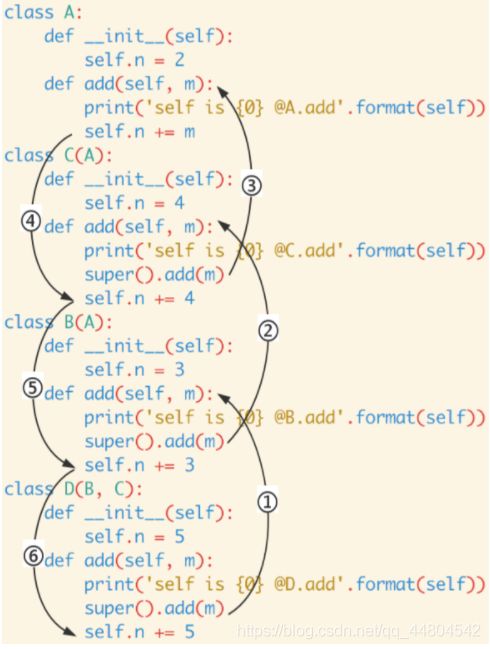Python基础:super()用法
概述
super() 是python 中调用父类(超类)的一种方法,在子类中可以通过super()方法来调用父类的方法。【超类: 是指 2层以上的继承关系,假如 C类继承B类,B类由继承A类,那么A类就是C类的超类】
作用:
- 在继承中,让代码维护更加简单
- 解决多继承带来的重复调用(菱形继承)、查找顺序(MRO)问题
语法:
super(type[, object-or-type])
参数:
type – 类。
object-or-type – 类,一般是 self
Python 3 和 Python 2 的另一个区别是: Python 3 可以使用直接使用 super().xxx 代替 super(Class, self).xxx :
super的使用
1.通过super() 来调用父类的__init__ 构造方法:
class Person():
def __init__(self):
print('我是Peson的__init__构造方法')
class Student(Person):
def __init__(self):
super().__init__()
print('我是Student的__init__构造方法')
stu = Student()
-----------------------------------------
我是Peson的__init__构造方法
我是Student的__init__构造方法
2 通过supper() 来调用与子类同名的父类方法
2.1 单继承
在单继承中 super 就像大家所想的那样,主要是用来调用父类的方法的。
class A:
def __init__(self):
self.n = 2
def add(self, m):
print('self is {0} @A.add'.format(self))
self.n += m
class B(A):
def __init__(self):
self.n = 3
def add(self, m):
print('self is {0} @B.add'.format(self))
super().add(m)
self.n += 3
b = B()
b.add(2)
print(b.n)
我们执行以上代码,得到的输出如下:
self is <__main__.B object at 0x106c49b38> @B.add
self is <__main__.B object at 0x106c49b38> @A.add
8
这个结果说明了两个问题:
1、super().add(m) 确实调用了父类 A 的 add 方法。
2、super().add(m) 调用父类方法 def add(self, m) 时, 此时父类中 self 并不是父类的实例而是子类的实例, 所以 b.add(2) 之后的结果是 5 而不是 4 。
补充说明:
MRO—方法搜索顺序
- MRO是method resolution order,主要用于在对继承是判断方法、属性的调用路径【顺序】,其实也就是继承父类方法时的顺序表。
- Python中针对类提供了一个内置属性__mro__可以查看方法的搜索顺序
class C(A,B):
pass
print(C.__mro__)
out:
(<class '__main__.C'>,<class'__main__.A'>,<class'__main__B'>,<class 'object'>)
在搜索方法时,是按照__mro__的输出结果从左到右的顺序查找的
- 如果当前类中找到方法,就直接执行,不再搜索
- 如果没有找到,就查找下一个类中是否有对应的方法,如果找到,就直接执行,不再搜索
- 如果找到最后一个类,还是没有找到方法,程序报错
2.2 多继承
在多继承中,会涉及到一个MRO(继承父类方法时的顺序表) 的调用排序问题。即严格按照MRO 顺序执行super方法
class A:
def __init__(self):
self.n = 2
def add(self, m):
print('self is {0} @A.add'.format(self))
self.n += m
class B(A):
def __init__(self):
self.n = 3
def add(self, m):
print('self is {0} @B.add'.format(self))
super().add(m)
self.n += 3
class C(A):
def __init__(self):
self.n = 4
def add(self, m):
print('self is {0} @C.add'.format(self))
super().add(m)
self.n += 4
class D(B, C):
def __init__(self):
self.n = 5
def add(self, m):
print('self is {0} @D.add'.format(self))
super().add(m)
self.n += 5
d = D()
d.add(2)
print(d.n)
out:
self is <__main__.D object at 0x10ce10e48> @D.add
self is <__main__.D object at 0x10ce10e48> @B.add
self is <__main__.D object at 0x10ce10e48> @C.add
self is <__main__.D object at 0x10ce10e48> @A.add
19
- 同样,不管往上调用几次,调用父类方法中 self 并不是父类的实例而是子类的实例,在上例中都是D的实例化对象
- D.mro() == [D,B, C, A, object] ,多继承的执行顺序会严格按照mro的顺序执行。
- 整体的调用流程图如下:
d = D()
d.n == 5
d.add(2)
class D(B, C): class B(A): class C(A): class A:
def add(self, m): def add(self, m): def add(self, m): def add(self, m):
super().add(m) 1.---> super().add(m) 2.---> super().add(m) 3.---> self.n += m
self.n += 5 <------6. self.n += 3 <----5. self.n += 4 <----4. <--|
(14+5=19) (11+3=14) (7+4=11) (5+2=7)

其它:
1.super().__init__相对于类名.init,在单继承上用法基本无差别
2.但在多继承上有区别,super方法能保证每个父类的方法只会执行一次,而使用类名的方法会导致方法被执行多次。
3.多继承时,使用super方法,对父类的传参数,应该是由于python中super的算法导致的原因,必须把参数全部传递,否则会报错
4.单继承时,使用super方法,则不能全部传递,只能传父类方法所需的参数,否则会报错